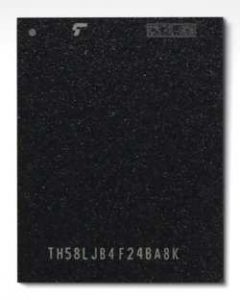Toshiba Memory: 96-Layer BiCS Flash 3D Memory …
1.33Tb capacity for single chip, and 16-die stacked architecture in single package with 2.66TB capacity
This is a Press Release edited by StorageNewsletter.com on July 24, 2018 at 2:24 pmToshiba Memory America, Inc. (TMA), the U.S.-based subsidiary of Toshiba Memory Corporation, announced the development of a prototype sample of 96-layer BiCS Flash, its proprietary 3D flash memory, with 4-bit-per-cell (quad level cell, QLC) technology.

With this achievement, the company demonstrates its technology leadership in the storage market by delivering technology that boosts single-chip memory capacity to the highest level yet achieved (1).
The QLC BiCS Flash expands capacity by pushing the bit count for data per memory cell from three to four. This product achieves the industry’s maximum capacity of 1.33 terabits (2) for a single chip, and a 16-die stacked architecture in a single package realizes a capacity of 2.66TB.
The number of applications needing huge amounts of storage continues to grow, fed by the enormous volumes of data being generated that need to be accessed and analyzed in real time. Social media, SSDs, edge computing, enterprise applications and the rapidly expanding data center storage market are all areas in which larger capacity storage is required – to name just a few. With the introduction of 96-layer QLC technology, the company enables the development of products that keep pace with the fast-moving storage market.
QLC technology has long been a part of the firm’s roadmap strategy for high-density, smaller chip size flash memory solutions: the company was the first to publicly discuss QLC technology (at the 2016 Flash Memory Summit) and one of the first to develop a 3D flash memory device that uses it.
“We were among the first in the industry to envision and prepare for the successful migration of SLC technology to MLC, from MLC to TLC, and now from TLC to QLC,” noted Scott Nelson, SVP, memory business unit, TMA. “This technology evolution has made increasingly dense packaging options available, and QLC will have a game-changing impact across many different markets.“
Samples of the company’s groundbreaking QLC device will begin shipping in early September to SSD and SSD controller vendors for evaluation and development purposes. Mass production is expected to begin in 2019.
Additionally, a packaged prototype will be showcased at the 2018 Flash Memory Summit, taking place from August 6-9 in Santa Clara, CA.
[1] Source: Toshiba Memory Corporation, as of July 19, 2018.
[2] Definition of capacity: Toshiba Memory Corporation defines 1GB as 1,000,000,000 bytes. A computer OS, however, reports storage capacity using powers of two for the definition of 1GB = 2*30 bytes = 1,073,741,824 bytes and therefore shows less storage capacity. Available storage capacity (including examples of various media files) will vary based on file size, formatting, settings, software and OS, such as Microsoft OS and/or pre-installed software applications, or media content. Actual formatted capacity may vary.













 Subscribe to our free daily newsletter
Subscribe to our free daily newsletter

